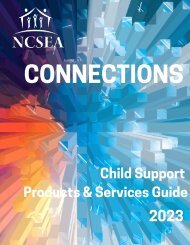April 2024 CSQ
You also want an ePaper? Increase the reach of your titles
YUMPU automatically turns print PDFs into web optimized ePapers that Google loves.
But title IV-D had a second purpose:<br />
welfare cost recovery. These cost recovery<br />
policies were part of an older history,<br />
rooted in Victorian-era poor relief laws that<br />
treated public assistance as a debt. Cost<br />
recovery laws have a long racist legacy,<br />
and the chronological arc of the “deadbeat<br />
parent” phase of the program mirrored the<br />
rise of incarceration and the retrenchment of<br />
public assistance programs.<br />
The right to child support itself is ancient. In fact, in<br />
1665, my ancestor, Herodias Long, successfully sued<br />
the father of her children for child support in Rhode Island, although they<br />
had never married. Since its inception, the child support program has<br />
struggled to reconcile the legal right of children to obtain parental support,<br />
the unequal economic footing of men and women, and reimbursement of<br />
cash assistance.<br />
Generational change has brought a different set of insights to the child<br />
support program. Many of the people who implemented title IV-D had<br />
experienced divorce and raised children as single mothers. Many of the<br />
legislators at that time were divorced fathers. Many of the people who<br />
make the child support program run today were once children who lived<br />
apart from a parent.<br />
The child support program has come a long way. My first job out of law<br />
school in 1982 was with the Minnesota Attorney General’s Office, where I<br />
represented the range of human services programs, including child<br />
support. Minnesota has a state-administered, county-run program. At that<br />
time, the state central office only had 4 or 5 staff. Except for the largest<br />
counties, child support cases were handled by private attorneys under<br />
county contract. Child support was enforced primarily through wage<br />
garnishment, civil contempt, and criminal prosecutions. In its earliest days,<br />
the child support program operated exclusively as a cost-recovery program.<br />
In 1984, Congress required states to expand services to parents who did<br />
not receive AFDC but requested services.<br />
I started working with the title IV-D program before child support guidelines<br />
were implemented. Order amounts varied widely. Low-income noncustodial<br />
parents of children receiving AFDC were typically charged the full amount<br />
of assistance paid out, including Medicaid birthing costs and retroactive















